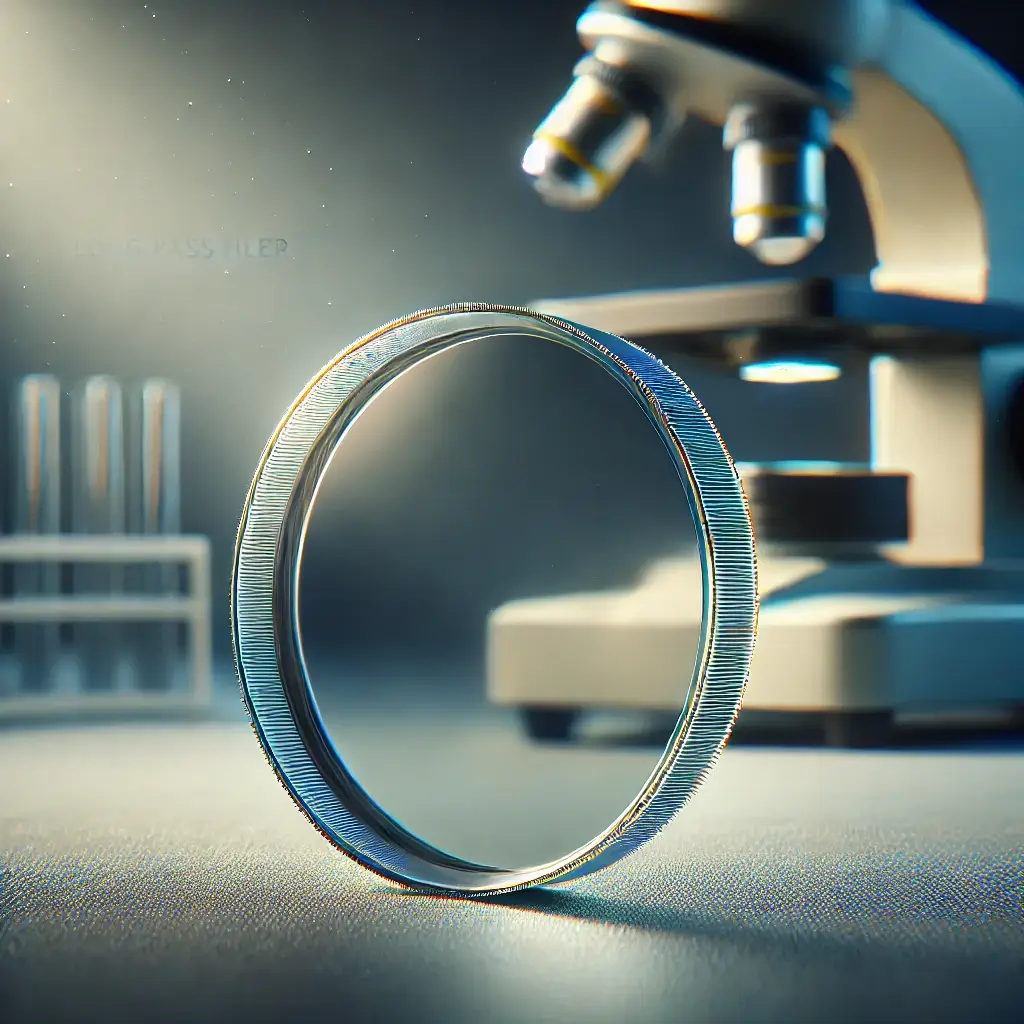Long pass filters play a key role in the manipulation of light waves by allowing longer wavelengths of light to pass through while blocking shorter wavelengths. Their importance covers everything from fluorescence microscopy to astronomy.
In this blog, we will take a deep dive into what longpass filters are, how they work, and their applications, and guide you through selecting the right filter for your specific needs.
What is a Long Pass Filter?

A long pass filter is a special type of optical filter that allows long wavelengths of light to pass through while blocking shorter wavelengths. This means that the filter sets a specific cut-off wavelength above which only light can pass.
Principle of Operation of Long Pass Filters
Long pass filters work by allowing light with wavelengths higher than a specified cutoff point to pass through while blocking shorter wavelengths. This mechanism enhances contrast and improves image quality in applications where longer wavelengths are required. Its main features and parameters are as follows
- Long pass filters have a steep cutoff edge that ensures that the transmission in the blocking range is close to zero and the transmission in the passband is close to 100%.
- The cutoff wavelength determines the transmission range of a long pass filter and is therefore a key parameter in filter selection.
Types of Long Pass Filters
Long pass filters contain two main types of filters, edge filters and Raman filters . They are distinguished mainly by the steepness of the cutoff curve:
Edge filters with a gentle slope
Edge filters have a moderate cutoff slope, allowing for a smooth transition from blocked to transmitted light in a given wavelength range.
They are typically used in applications where wavelength separation accuracy is not required, such as general photography or basic scientific instruments. The gentle slope allows transmission of a wider range of light, making these filters versatile, but with less filtering power.
Steep Slope Raman Filters
Raman filters have a very steep cutoff curve and are often used in Raman spectroscopy. The steep curve allows precise separation of Raman scattering from strongly Rayleigh scattered light and fluorescence.
This high degree of selectivity allows for the accurate detection of weak Raman signals at wavelengths close to the laser line, ensuring the clarity and specificity of the spectral data obtained.
The difference between the slopes of the fringes and Raman filters allows them to perform specific functions in a variety of optical and spectroscopic applications and to optimize performance according to the required precision and specificity of the wavelength separation.
Applications of Long Pass Filters

Scientific Research
In microscopy, long pass filters enhance contrast and maximize sample fluorescence. They play a key role in isolating specific wavelengths for accurate imaging and analysis.
For spectroscopic applications, long pass filters act as band separators, ensuring accurate spectral manipulation. By transmitting longer wavelengths and attenuating shorter wavelengths, these filters help improve the accuracy and reliability of spectral measurements.
Industrial Uses
In imaging systems, long pass filters eliminate optical distortion and improve image quality. By selectively allowing longer wavelengths to pass, these filters optimize the performance of imaging equipment in a variety of industrial environments.
In laser systems, long pass filters block shorter wavelengths that are not needed. This ensures efficient and accurate laser operation by keeping the desired wavelength output undisturbed.
Everyday Applications
In photography, long pass filters control the amount of light entering the camera lens, helping the photographer to achieve specific artistic effects. By filtering out shorter wavelengths, these filters enhance color saturation and contrast in photographs.
For consumer electronics, long pass filters are integrated into displays to improve image clarity and reduce glare. By selectively transmitting longer wavelengths, these filters enhance the user’s visual experience on different electronic devices.
Choosing the Right Long Pass Filter
When selecting a long pass filter, not only the wavelength range needs to be considered, but also a comprehensive evaluation and consideration from several aspects:
- The wavelength range is a key factor to be evaluated. It determines which specific wavelengths will be transmitted and which shorter wavelengths will be blocked.
- Ensure that the filter selected meets your desired wavelength requirements for optimal performance in your application.
- Another important aspect to evaluate is the material and durability of the filter.
- Choose filters made of fused quartz or float glass to guarantee durability in different environments.
- Comparing brands of longpass filters helps gauge their quality and equipment compatibility.
- Consider brand reputation, customer feedback, and technical support to choose the right filter.
- When investing in a long pass filter, you should strike a reasonable balance between cost and performance.
- Consider not only the initial purchase price, but also the long-term benefits and performance efficiencies offered by each filter option on the market.
A Practical Guide to Using Long Pass Filters
When installing long pass filters, consider the mounting options available to ensure safe placement in the optical system. And choose a mounting method that provides stability and precision, enhancing the filter’s ability to efficiently transmit specific wavelengths.
Prioritize alignment accuracy during setup for precise wavelength transmission and blocking. Utilize alignment tools and techniques to fine-tune the position of filters in optical equipment to ensure consistent and reliable performance. Regularly check and adjust the alignment of filters to maintain their
Maintenance and Care
- Use gentle cleaning methods to maintain the quality and effectiveness of the long pass filter during routine maintenance.
- Use solvents or cleaning solutions suitable for optical filters to remove dust particles or stains without damaging the coating or substrate of the filter.
- Avoid abrasive materials or harsh cleaners that may compromise the integrity of the filter; instead, choose a soft, lint-free cloth for gentle cleaning.
- Follow specific storage recommendations to protect long pass filters when not in use, extending their life and maintaining optimal performance.
- Store filters in protective packaging or boxes designed for optics to protect them from dust, moisture and potential physical damage.
- Control humidity levels in the storage environment to prevent condensation or mold growth on filter surfaces and maintain their clarity and transmission performance.
Summarizing
In summary, review the fundamentals of long pass filters to enhance your optical research. Discover the critical role these filters play in applications ranging from scientific research to everyday photography.
Find the best longpass filter for your specific needs. Enhance your understanding and experimental capabilities in optics with the versatility and precision longpass filters offer.
What Can Optolong do for Us?
Optolong is a professional company specializing in the research, development, production, and sales of optical filters. Our main products include various types of optical filters, infrared filters, ultraviolet filters, long pass filters, and more.
Optolong is dedicated to providing high-quality optical filter products and comprehensive services to help customers achieve better results in various optical applications. Please contact us for an accurate quote and detailed information. Our professional team is ready to serve you!
Related reading: What is dichroic mirror?
